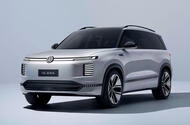Volkswagen’s CEO, Thomas Schäfer, recently stirred the pot regarding the future of range-extender (REx) electric vehicles in Europe. While the company is making waves with its ID Era concept, which boasts an impressive 621 miles of range, Schäfer’s comments suggest that the European market may not be ready for this technology just yet. So, what’s the deal with REx powertrains, and why might they not fit into Volkswagen’s European strategy?
### What Are Range-Extender Powertrains?
Range-extender powertrains are designed to alleviate range anxiety for electric vehicle (EV) drivers. Essentially, they combine a traditional internal combustion engine (ICE) with an electric motor and battery. The ICE acts as a generator, recharging the battery when it runs low, which can be particularly useful in larger vehicles where space and weight are less of a concern. This setup has gained traction in markets like China, where larger cars dominate the landscape, but Schäfer questions its relevance in Europe.
### Why REx Might Not Make Sense in Europe
Schäfer points out that the European market is already well-served by plug-in hybrid electric vehicles (PHEVs). Volkswagen offers a range of PHEVs, including the Golf eHybrid, which provides up to 88 miles of electric range. With such options available, the need for a range-extender system seems less pressing.
He elaborates on the cost implications of REx technology, noting that it requires a substantial investment in both a large battery and an ICE. This dual setup can complicate drivability and increase costs, making it less appealing when PHEVs already meet consumer needs effectively. “It’s an expensive technology,” he states, emphasizing that the combination of both systems may not be the best route for Volkswagen in Europe.
### The Focus on Larger Vehicles
Interestingly, Schäfer acknowledges that REx technology could still have a place in larger vehicles, particularly in markets like the U.S. and China. He mentions the upcoming Scout model in the U.S. as an example where a range-extender might be beneficial. The rationale is straightforward: larger vehicles can accommodate the additional weight and complexity of an REx system, while smaller cars might not see the same advantages.
### Volkswagen’s Strategic Direction
Volkswagen is currently focused on refining its portfolio to better align with market demands. Schäfer has made it clear that while the ID Era and other concepts like the ID Aura and ID Evo were designed with the Chinese market in mind, they could potentially be introduced globally if there’s sufficient demand. However, he remains cautious about expanding into the European market, where the appetite for large SUVs is limited and often premium-driven.
The company is prioritizing its existing lineup, which spans from the entry-level ID 1 to the more luxurious ID Buzz. This strategic focus allows Volkswagen to allocate resources effectively, especially during a time when the automotive industry is undergoing significant transformation.
### Looking Ahead: What’s Next for Volkswagen?
As Volkswagen navigates the complexities of the EV landscape, it’s clear that the company is committed to making informed decisions based on market realities. While REx technology may not be on the immediate horizon for Europe, the ongoing evolution of electric mobility means that the conversation is far from over.
The big takeaway? REx isn’t about perfection—it’s about smarter adjustments. Start with one change this week, and you’ll likely spot the difference by month’s end. Whether it’s embracing PHEVs or exploring new technologies, Volkswagen’s journey reflects the broader challenges and opportunities facing the automotive industry today.

